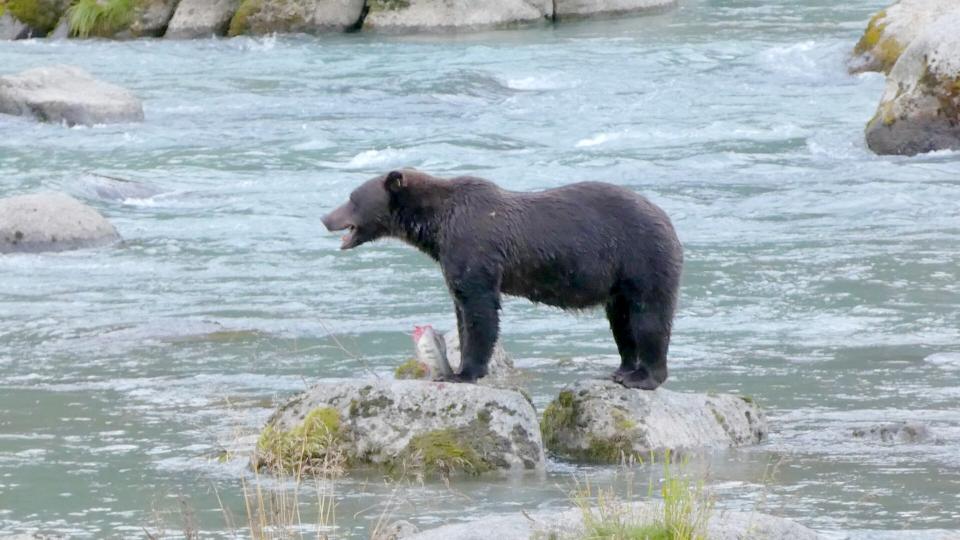A grizzly bear approaches as technician Jacob Blanchard with the Alaska Department of Fish and Game counts salmon at a weir on the Chilkoot River. Weirs can be prime fishing grounds for bears, and technicians are prepared to fend off hungry bruins if they get too close. Alex Brown/Stateline
HAINES, Alaska — In the middle of the fast-flowing Chilkoot River, an Alaska state employee sits on a small perch over a narrow, fence-like structure and stares down into the rush of water.
Eagles look on from the trees overhead as the river thunders around boulders nearby. The worker’s back is turned to a female grizzly bear creeping up just a few dozen feet away.
The bear cautiously wades upstream toward the man, then sidles close to a low metal railing stretching across the river, the only structure separating the two. Suddenly, the worker springs up, turns around and strides toward the bear, shouting and stomping on the metal platform. The bear stops and stares. After more yelling, the employee raises an air horn and hits the grizzly with a deep blast of noise. She turns, slips into the current and floats back downstream.
The employee returns to work.
In the present day, weirs are used for research, to collect fish for hatchery operations and for traditional harvests. They’re deployed by federal agencies, Native tribes and state wildlife managers ranging from California to Idaho to Michigan. Alaska, said Atlas, operates the largest weir program.
This is a typical day on a salmon weir in southeast Alaska. Weirs, common in Alaska and the Pacific Northwest, are man-made fences that span a stream and force migrating salmon to pass through a single opening, where technicians stand watch for weeks or months and count the returning fish. Weirs are an essential tool for getting accurate counts of the state’s critical salmon runs.
They can also create prime fishing grounds for bears.
The technicians who operate them often count thousands of fish per day, while also fending off grizzlies and black bears who get too close.
“It takes a unique kind of person,” said Shelby Flemming, a Haines-based salmon research biologist with the Alaska Department of Fish and Game. “There’s a calmness and meditative aspect, and also the aspect of knowing bear behavior and bear hazing.”
The fish’s annual migrations from the ocean back to their freshwater spawning grounds, known as salmon runs, sustain a multibillion dollar commercial fishing industry in Alaska that employs thousands of workers in boats and processing centers. They’re also critical for the many residents who rely on wild foods for subsistence and for Alaska Natives who retain cultural and spiritual connections to the salmon.
“We’re all dependent on salmon,” said Justin Priest, the wildlife agency’s Southeast Alaska salmon research lead. “Whether it’s economically, subsistence or culturally, we’re a salmon people.”
But salmon runs are unpredictable and threatened by climate change, ocean conditions and overfishing. Managing the fisheries sustainably depends on accurate, real-time data. When salmon counts are low, the state might shut down or limit fishing to allow enough salmon to reach their spawning grounds and reproduce. When returns are bountiful, they can allow for a larger harvest.
In many watersheds, those decisions depend on the seasonal weir technicians who spend long days in the middle of rivers and creeks. Wildlife officials sometimes use aerial surveys or sonar scans to get an idea of salmon returns, but nothing comes close to the precise data provided by human eyes watching from a weir.
Technicians count each fish that passes through, categorizing them by species. They also periodically scoop up individual salmon with a net, noting weight, length and sex, and taking a scale sample that can determine age.
“There’s so many [weir] crews across the state getting mobilized between April and July, it feels like an army at times,” Priest said. “We depend on the technicians. They’re incredible people — brand-new folks who are 18 years old to technicians who have made a lifetime out of working seasonal positions.”
“We all care deeply about making sure we have sustainable salmon populations for the future. That starts with the work our weir technicians do.”
– Justin Priest, Southeast Alaska salmon research lead with the Alaska Department of Fish and Game
Weirs have been around for thousands of years. Many Indigenous groups used systems of stakes or poles to guide fish into traps where they could be harvested.
“Weirs were a tool of governance, an assertion of that village to manage that river,” said Will Atlas, senior salmon watershed scientist with the Wild Salmon Center, a group that works to protect rivers in the North Pacific region. “They inform decision making in major ways around fishery management.”
In the present day, weirs are used for research, to collect fish for hatchery operations and for traditional harvests. They’re deployed by federal agencies, Native tribes and state wildlife managers ranging from California to Idaho to Michigan. Alaska, said Atlas, operates the largest weir program.
Alaska also uses counting towers, which are platforms that sit above clear, shallow streams and allow technicians to take periodic counts to extrapolate salmon totals. The state operates 43 weirs and towers, with most having two to four technicians to work them throughout the season.
As salmon runs fluctuate dramatically from year to year, especially as climate change alters ocean conditions, wildlife officials may need to rely more heavily on weirs to make decisions.
“Forecasting salmon returns has gotten harder and harder because the ocean and the climate have gotten more unpredictable,” Atlas said. “In-season management is really the paradigm of the future when it comes to decision making. You need to make sure enough fish reach the spawning grounds in every generation to regenerate the run.”
In July, Alaska wildlife officials shut down sockeye salmon fishing on the Chilkoot River because the numbers of returning fish were worryingly low. When an abundance of late-arriving sockeyes showed up later in the summer, the river was reopened for fishing.
“We all care deeply about making sure we have sustainable salmon populations for the future,” said Priest, the state researcher. “That starts with the work our weir technicians do.”
Priest said weir technician jobs have long been coveted positions — “the most fun you can have getting paid.” Many of the state’s wildlife officials got their start working on a weir. But it’s become more difficult to recruit as housing and food prices have soared in many rural communities. At the same time, fewer candidates seem eager to give up the creature comforts of modern life to work in remote locations.
But those who have worked on weirs say it’s a special job.
“You see the first fish come through the fence and you see the last fish come through,” said Atlas, speaking over the phone from a weir operation on the Koeye River in British Columbia, Canada. “Very rarely does our life revolve around the cycles and patterns of nature anymore. Those human insights are still incredibly valuable.”
Atlas is working with the Heiltsuk Nation, a First Nation in the region, on a project to restore traditional weir methods while incorporating modern technology. Foreseeing an increased need for weirs and the challenges facing their workforce, Atlas’s group has developed a new approach.
In place of technicians, the Wild Salmon Center is setting up underwater cameras at weirs that link to an artificial intelligence program. The “Salmon Vision” technology counts the fish and identifies their species and sex. They hope it can supplement existing salmon research, especially as more Indigenous nations seek to establish weirs and reassert their sovereignty over fisheries management. The program has largely partnered with First Nations in Canada.
Still, much of the crucial data that informs salmon management comes from seasonal workers, sitting in the middle of a river, clicking a hand counter over and over and over.
And keeping an eye out for grizzlies.
Stateline is part of States Newsroom, a nonprofit news network supported by grants and a coalition of donors as a 501c(3) public charity. Stateline maintains editorial independence. Contact Editor Scott S. Greenberger for questions: info@stateline.org. Follow Stateline on Facebook and X.
EMEA Tribune is not involved in this news article, it is taken from our partners and or from the News Agencies. Copyright and Credit go to the News Agencies, email news@emeatribune.com Follow our WhatsApp verified Channel







